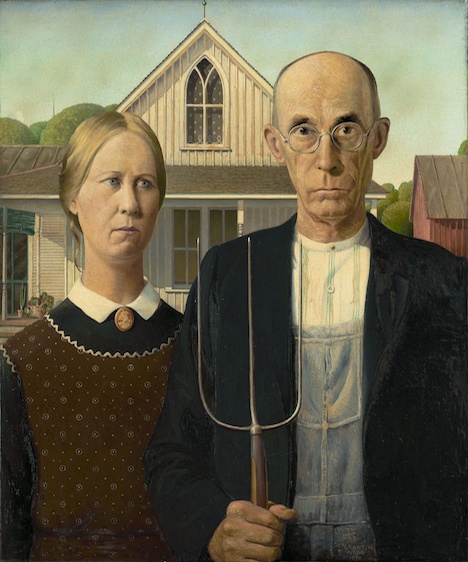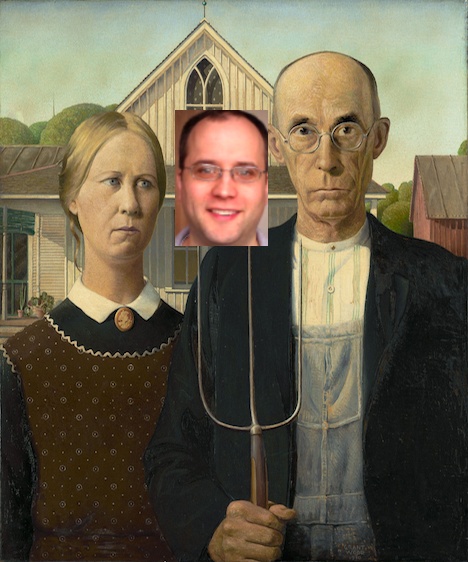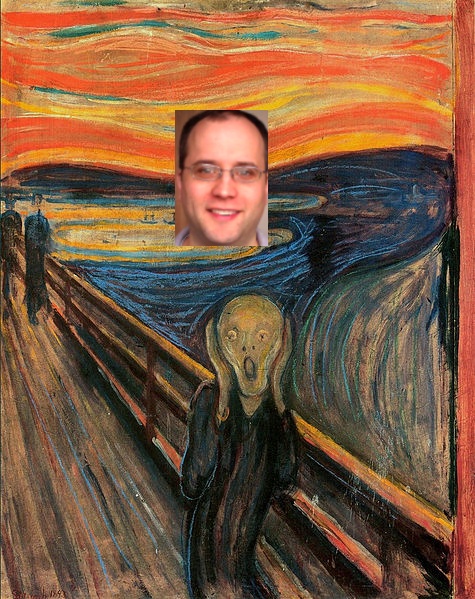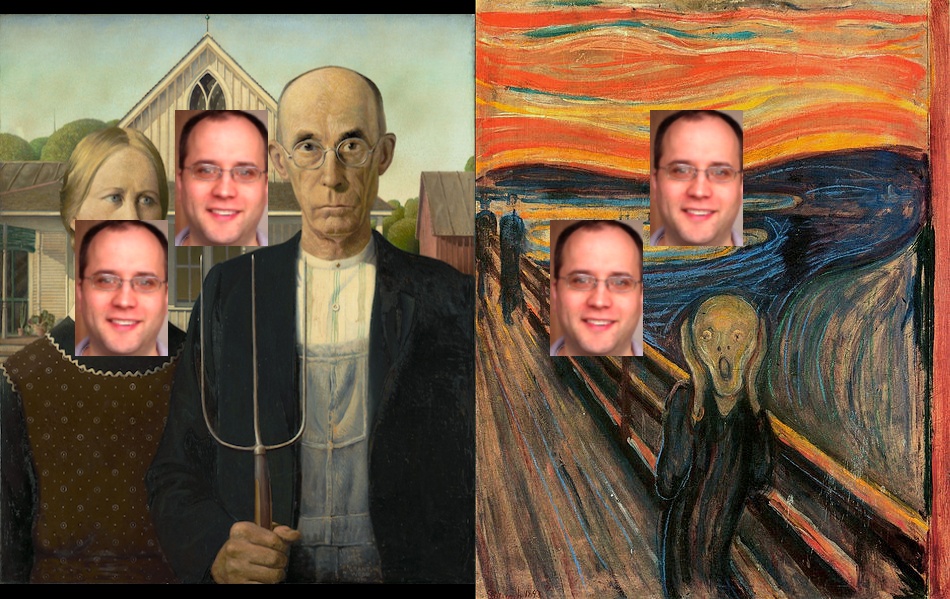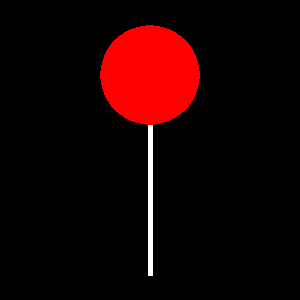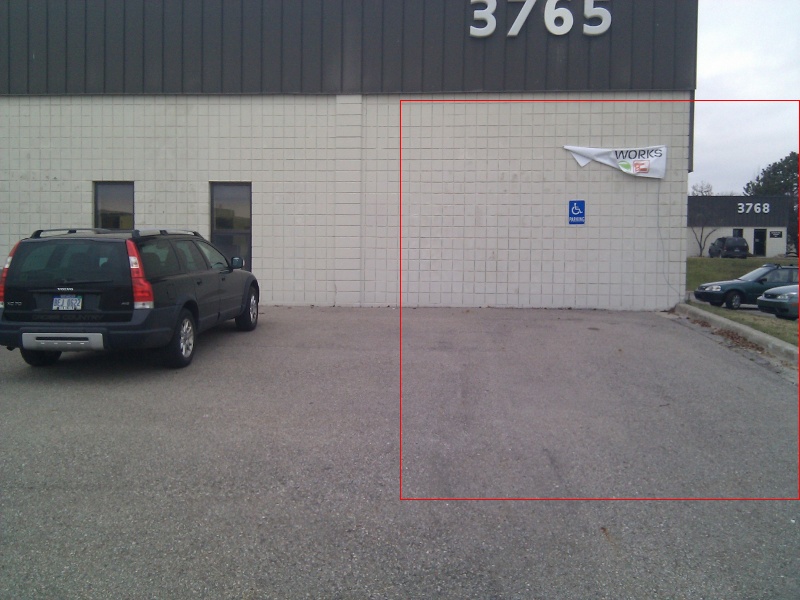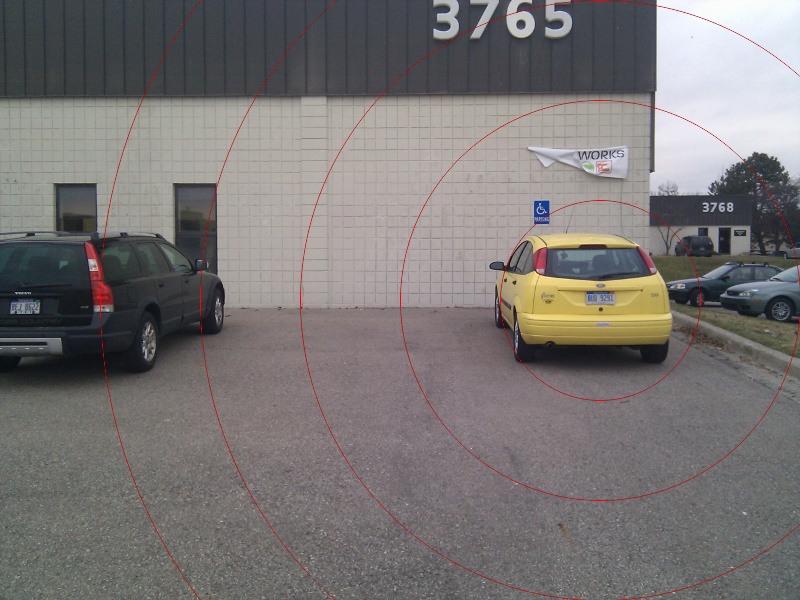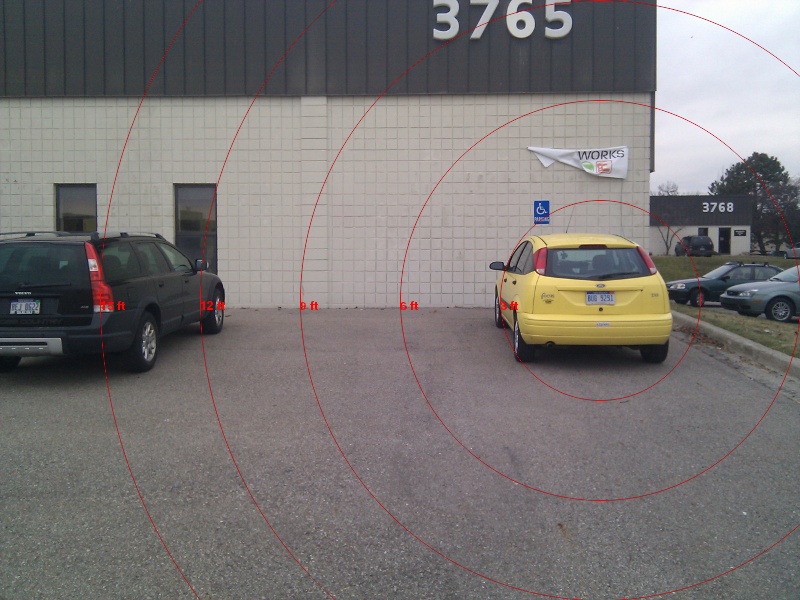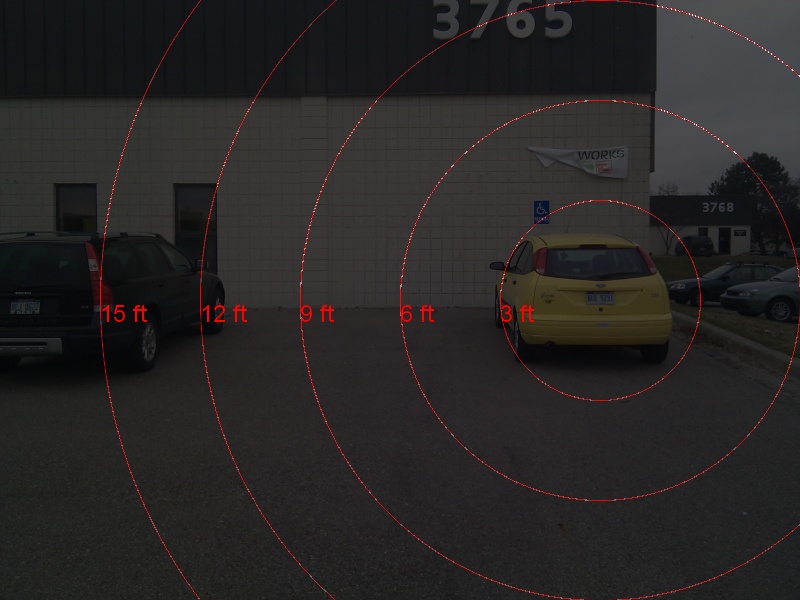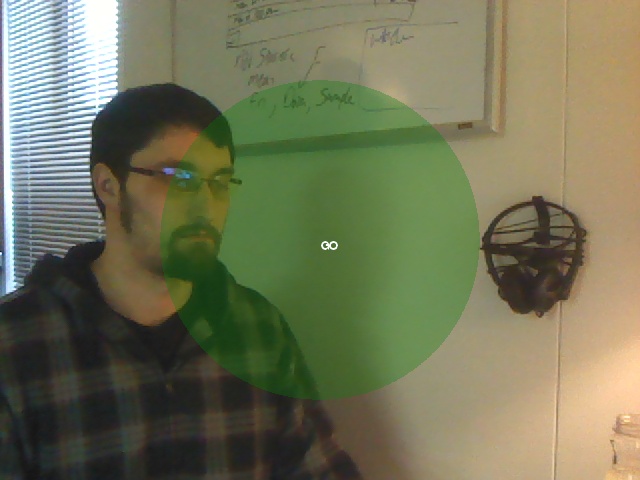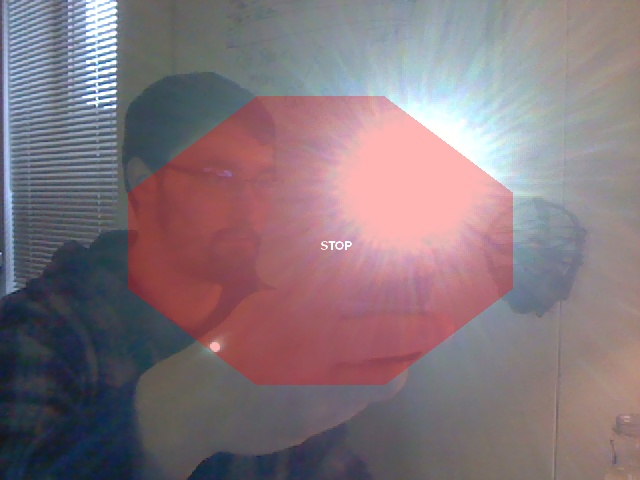Vision systems usually need to provide some form of feedback to its users. Although this could be in the form of messages printed to a log, a spreadsheet, or other data output, users are most comfortable with graphical output, in which key information is drawn directly on the image. This feedback is often more user-friendly because it is noticeable and can give the user more context about the message. When the program claims to have found features on an image, which ones did it find? Was it picking up noise? Is it finding the right objects? Even if the program will ultimately run without any user interaction, this type of feedback during development is vital. If, on the other hand, the system is designed to have users interacting with it, then drawing on images can be an important means for improving the user interface. For example, if the system measures several different objects, rather than printing a list of measurements to a console, it would be easier for the operator if the measurements were printed directly on the screen next to each object. This spares the operator from having to guess which measurements correspond to the different objects on the screen or trying to estimate which object is the correct one based on their coordinates.
The SimpleCV framework has a variety of methods for drawing on and marking up images. Some of these are standard tools, found in most basic image manipulation programs. These are functions like drawing boxes, circles, or text on the screen. The SimpleCV framework also includes features more commonly found in intermediate or higher end applications, such as manipulating layers. In general, this chapter covers:
A review of the
Displayobject and how images interact with itAn introduction to layers and the default Drawing Layer
Drawing lines and circles
Manipulating text and its various characteristics such as color, font, text size, and so on.
Rather than recklessly diving right into drawing, it would be
helpful to first understand the canvas. In Chapter 2,
the Display object was introduced. This
represents the window in which the image is displayed. The SimpleCV
framework currently only supports a single display window at a time and
only one image can be displayed in that window. In most cases, the display
is automatically created based on the size of the image to be displayed.
However, if the display is manually initialized, the image will be
automatically scaled or padded to fit into the display.
Tip
To work around the single display limitation, two images can be
pasted side-by-side into a single larger image. The sideBySide() function does this automatically.
For example, img1.sideBySide(img2)
will place the two images side by side. Then these two images can be
drawn to the single window, helping to work around the single window
limitation.
from SimpleCV import Display, Camera, Image display = Display(resolution = (800, 400))cam = Camera(0, {'width': 320, 'height': 240})
img = cam.getImage() img.save(display)
# Should print: (320, 240) print img.size()

Initialize the display. Notice that the display’s resolution is intentionally set to a very strange aspect ratio. This is to demonstrate how the image then fits into the resulting window.

Initialize the camera. The camera is intentionally initialized with smaller dimensions and a different aspect ratio than the display.

As mentioned in Chapter 1, “saving” an image to the display shows it in the window.
Figure 7-1. Left: The image as captured by the camera; Right: The image was scaled up so that it vertically filled the display, and then padding is added to the right and left to horizontally fill the display
Notice the result in this case. The window remains 800×400. The image is scaled
up so that the height now matches the 400 pixels of the window. Then padding is added to the
left and right sides. The effect is similar to the adaptiveScale() function. The original image size is not altered. You can see
this effect in Figure 7-1. It remains 320×240 as is shown in the print statement, but it is scaled for
display.
Images can also be divided into layers. Layers act like multiple images that sit on top of each other. The order of the layers is important. Items on the top layer cover items in the same area on the layer beneath it. Otherwise, if there is nothing covering them, the items from the lower layers will show through. Although all processing could be done on a single layer of an image, multiple layers can simplify processing. For example, the original image can sit on the bottom layer, and then lines drawn around the edges of objects can appear on the next layer up. Then, text describing the object can sit on the top layer. This preserves the original image while ensuring that the drawings and markup appear to the end user.
With the preliminaries aside, it is time to start drawing. Layers
are implemented in the DrawingLayer
class. For those who have previous experience working with PyGame, a
DrawingLayer is a wrapper around
PyGame’s Surface class. This class has
features for drawing text, managing fonts, drawing shapes, and generally
marking up an image. Remember that one key advantage is that this all
occurs on a layer above the main image, leaving the original image intact.
This enables convenient markup while preserving the image for
analysis.
Note
When saving an image with layers, the saved image is flattened—all
of the data is merged together so that it appears as a single layer. The
Image object itself remains separated into
layers.
One of the easiest examples of using a layer is to draw one image on top of another. The following example demonstrates how to insert yourself into the classic American Gothic painting (by Grant Wood), as demonstrated in Figure 7-2.
from SimpleCV import Image
head = Image('head.png')
amgothic = Image('amgothic.png')
amgothic.dl().blit(head, (175, 110))  amgothic.show()
amgothic.show()
The
dl()function is just a shortcut for thegetDrawingLayer()function. Because the layer did not already exist,dl()created the layer so that it could hold the face. Thenblit()function—which is short for BLock Image Transfer—copied the provided image onto the background. The first parameter is the image to add, the second parameter is the coordinate at which to add the image.
The resulting program adds a third person into the image, as demonstrated in Figure 7-3.
Note
The blit() function can be used
without layers, too. For example, newImage =
amgoth.blit(head) creates a new flat image (without layers)
that appears exactly the same. However, in this case, the face is copied
right onto the main image and any information about the original pixels
that are covered in that spot are lost.
A lot of stuff is happening under the hood in the previous example. To look at this in more detail, consider the following example, which works with the underlying layers:
from SimpleCV import Image, DrawingLayer
amgothic = Image('amgothic.png')
size = amgothic.size()
# Prints the image size: (468, 562)
print size
# Prints something like: [<SimpleCV.DrawingLayer object size (468, 562)>]
print amgothic.layers()  layer1 = DrawingLayer(size)
layer1 = DrawingLayer(size)  amgothic.addDrawingLayer(layer1)
amgothic.addDrawingLayer(layer1)  # Prints information for two DrawingLayer objects
print amgothic.layers()
# Prints information for two DrawingLayer objects
print amgothic.layers()The above code essentially manually does everything that was done
earlier with background.dl(). Obviously
this is more complex, but it shows in more detail how to work with
layers:

The
layers()property represents the list of all of the layers on the image.
This creates a new drawing layer. By passing
DrawingLayer()a tuple with the width and height of the original image, it creates a new layer that is the same size. At this point, the layer is not attached to the image.
The
addDrawingLayer()function adds the layer to the image, and appends it as the top layer. To add a layer in a different order, use theinsertDrawingLayer()function instead.
The above process—creating a drawing layer and then adding it to an image—can be repeated over and over again. The layer added in the example above does not do anything yet. The next example shows how to get access to the layers so that they can be manipulated.
# This code is a continuation of the previous block of example code # Outputs: 2 print len(amgothic.layers()) drawing = amgothic.getDrawingLayer()drawing = amgothic.getDrawingLayer(1)
In the previous examples, a drawing layer is first created, and then that drawing layer is added to an image. The layer is not actually fixed to the image. Instead, a layer from one image can actually be applied to another image. The following example builds off the first example in this chapter, where a face was placed on an image. This re-extracts the face from a layer, and then copies that whole layer to a new image.
from SimpleCV import Image, DrawingLayer
head = Image('head.png')
amgothic = Image('amgothic.png')
scream = Image('scream.png')
amgothic.dl().blit(head, (175, 110))  layer = amgothic.getDrawingLayer()
layer = amgothic.getDrawingLayer()  scream.addDrawingLayer(layer)
scream.addDrawingLayer(layer)  scream.show()
scream.show()
Up to this point, the example is similar to what we have seen before. This line adds the third head onto the American Gothic image.

We then extract the layer back from the American Gothic image using the
getDrawingLayer()function. In this case, there is just one layer, so no index is required when retrieving the layer.
Next, copy that layer to the image of The Scream. This will add a floating head above the screaming person in the original image. Note that even though the layer from the American Gothic image is a different size than The Scream image, the layer can still be copied.
The resulting image will look like Figure 7-4.
As demonstrated above, when copying a layer between images, the same layer is actually shown on both images. In other words, when a layer is modified, the resulting change appears on both images.
# This is a continuation of the previous block of example code print amgothic._mLayersprint scream._mLayers layer.blit(head, (75, 220))
amgothic.show()
scream.show()

These two print statements should print out identical information, showing that it’s the same object.

By passing the coordinates
(75, 220)into theblitfunction, you are adding a second copy of the head image to the layer.
Even though the layer was changed in one spot, the result propagates to both images.
Notice that now the change appears on both images, as demonstrated in Figure 7-5.
The SimpleCV framework includes tools to draw several basic shapes such as lines, bezier curves, circles, ellipses, squares, and polygons. To demonstrate the true power of the drawing engine, Figure 7-6 is a rendering of a lollipop (there is a reason we did not go to art school):
from SimpleCV import Image, Color img = Image((300,300))img.dl().circle((150, 75), 50, Color.RED, filled = True)
img.dl().line((150, 125), (150, 275), Color.WHITE, width = 5)
img.show()
Most of the time, rather than drawing on a blank image, we want to mark up existing data. Here, we show how to mark up the camera feed to make it easier to find and calibrate the center by adding markup similar to a scope (see Figure 7-7):
from SimpleCV import Camera, Color, Display
cam = Camera()
size = cam.getImage().size()
disp = Display(size)
center = (size[0] /2, size[1] / 2)
while disp.isNotDone():
img = cam.getImage()
# Draws the inside circle
img.dl().circle(center, 50, Color.BLACK, width = 3)  # Draws the outside circle
img.dl().circle(center, 200, Color.BLACK, width = 6)
# Draws the outside circle
img.dl().circle(center, 200, Color.BLACK, width = 6)  # Draw the radiating lines
img.dl().line((center[0], center[1] - 50), (center[0], 0),
Color.BLACK, width = 2)
img.dl().line((center[0], center[1] + 50), (center[0], size[1]),
Color.BLACK, width = 2)
img.dl().line((center[0] - 50, center[1]), (0, center[1]),
Color.BLACK, width = 2)
img.dl().line((center[0] + 50, center[1]), (size[0], center[1]),
Color.BLACK, width = 2)
img.save(disp)
# Draw the radiating lines
img.dl().line((center[0], center[1] - 50), (center[0], 0),
Color.BLACK, width = 2)
img.dl().line((center[0], center[1] + 50), (center[0], size[1]),
Color.BLACK, width = 2)
img.dl().line((center[0] - 50, center[1]), (0, center[1]),
Color.BLACK, width = 2)
img.dl().line((center[0] + 50, center[1]), (size[0], center[1]),
Color.BLACK, width = 2)
img.save(disp)We can also manage layers independently of images. Because the scope marks are the same in each frame, we can draw them once and apply the layer to subsequent images. This reduces the amount of processing that must be done on each frame.
from SimpleCV import Camera, Color, Display, DrawingLayer
cam = Camera()
size = cam.getImage().size()
disp = Display(size)
center = (size[0] /2, size[1] / 2)
# Create a new layer and draw on it
scopelayer = DrawingLayer(size)
# This part works just like the previous example
scopelayer.circle(center, 50, Color.BLACK, width = 3)
scopelayer.circle(center, 200, Color.BLACK, width = 6)
scopelayer.line((center[0], center[1] - 50), (center[0], 0),
Color.BLACK, width = 2)
scopelayer.line((center[0], center[1] + 50), (center[0], size[1]),
Color.BLACK, width = 2)
scopelayer.line((center[0] - 50, center[1]), (0, center[1]),
Color.BLACK, width = 2)
scopelayer.line((center[0] + 50, center[1]), (size[0], center[1]),
Color.BLACK, width = 2)
while disp.isNotDone():
img = cam.getImage()
# Rather than a lot of drawing code, now we
# can just add the layer to the image
img.addDrawingLayer(scopelayer)
img.save(disp)When using markup on images, it’s often a good idea to use it to highlight regions of interest, as in this example which uses the parking photo first demonstrated in Chapter 4. To demonstrate to the application user the part of the image that will be cropped, we can draw a box around the relevant region:
from SimpleCV import Image, Color, DrawingLayer
car = Image('parking-car.png')
boxLayer = DrawingLayer((car.width, car.height))  boxLayer.rectangle((400, 100), (400, 400), color=Color.RED)
boxLayer.rectangle((400, 100), (400, 400), color=Color.RED)  car.addDrawingLayer(boxLayer)
car.addDrawingLayer(boxLayer)  car.show()
car.show()
First, construct a new drawing layer to draw the box.

Next, draw a rectangle on the layer using the
rectangle()function. The first tuple is the(x, y)coordinates of the upper left corner of the rectangle. The second tuple represents the height and width of the rectangle. It is also colored red to make it stand out more.
Now add the layer with the rectangle onto the original image.
This block of code produces output as demonstrated in Figure 7-8.
This layer can then be used to compare the crop region with the parking image without a car. This will help to compare the regions of interest between the two versions of the photos.
# This is a continuation of the previous example
nocar = Image('parking-no-car.png')
nocar.addDrawingLayer(boxLayer)This works just like the previous example, except that now it shows the region of interest on the similar image without the illegally parked car. The resulting photo should look like Figure 7-9.
For a slight variation on the above example, drawing circles on the image could help to identify the distance between objects. For example, using the same example image as above, assume that 100 pixels is about 3 feet. How far away is the Volvo on the left from the illegal parking spot? One way to visually estimate the distance is to draw a series of concentric circles radiating out from the handicap parking space, as shown in Figure 7-9.
from SimpleCV import Image, Color, DrawingLayer
car = Image('parking-car.png')
parkingSpot = (600, 300)  circleLayer = DrawingLayer((car.width, car.height))
circleLayer = DrawingLayer((car.width, car.height))  circleLayer.circle(parkingSpot, 100, color=Color.RED)
circleLayer.circle(parkingSpot, 100, color=Color.RED)  circleLayer.circle(parkingSpot, 200, color=Color.RED)
circleLayer.circle(parkingSpot, 300, color=Color.RED)
circleLayer.circle(parkingSpot, 400, color=Color.RED)
circleLayer.circle(parkingSpot, 500, color=Color.RED)
car.addDrawingLayer(circleLayer)
circleLayer.circle(parkingSpot, 200, color=Color.RED)
circleLayer.circle(parkingSpot, 300, color=Color.RED)
circleLayer.circle(parkingSpot, 400, color=Color.RED)
circleLayer.circle(parkingSpot, 500, color=Color.RED)
car.addDrawingLayer(circleLayer)  car.show()
car.show()
Because this example draws a bunch of concentric circles, it is easier to simply define the center once rather than constantly retyping it. This point corresponds approximately to the middle of the handicap spot.

This line of code should be familiar from the rectangle drawing example. Create a new drawing layer with the same dimensions as the underlying image.

Draw the circle using the
circle()function. The first parameter is the center of the circle, which was defined in step 1. The second parameter sets the radius of the circle. The third parameter sets the color. It defaults to black, so a red circle is specified to make it appear more obvious on the image.
This line of code should now look familiar. It adds the new drawing layer to the image.
The resulting image should look like the image in Figure 7-10. Based on the image, the car is four to five circles away from the center of the handicap spot. Because the radius increased by 100 pixels per circle, that translates into 400 to 500 pixels. Under the rough assumption that 100 pixels equals three feet, then the Volvo is currently around 15 feet away from the center of the illegal parking space. It is probably safe to assume that it is legally parked.
Note
Chapter 8 demonstrates a more rigorous approach to measuring between objects on an image.
After all this drawing, it may be necessary to remove all the code
and start over with a clean slate. To clear the image, use the clearLayers() function.
# This is a continuation of the previous example car.clearLayers() car.show() print car.layers()
The car image is back to its original state before the circles were
drawn. Visually, the circles no longer appear. When printing out a list of
all the layers on the image, no layers appear. Note, however, that the
original circleLayer object still
exists. It can be placed back on the image with the addDrawingLayer() function.
This section did not cover all of the possible shapes, but it did present the standard approach. Several other frequently used options for drawing include:
- Line:
line(start=(x1, y1), end=(x2, y2)) Draws a straight line between the two provided points.
- Ellipses:
ellipse(center=(x, y), dimensions = (width, height)) Draws a “squished” circle.
- Centered Rectangle:
centeredRectangle(center=(x, y), dimensions=(x,y)) Similar to
rectangle(), except the center point is provided instead of the upper-left corner, in some cases saving some arithmetic.- Polygon:
polygon(points = [ (x1, y1), (x2, y2), (x3, y3) …]) By providing a list of
(x, y)points, this will draw lines between all connected points.- Bézier Curve:
bezier(points = (p1, p1, p3, p4, …), steps=s) Draws a curve based on the specified control points and the number of steps.
Displaying text on the screen is fairly simple. In the previous example using circles to show distances, the example assumed that users knew that each circle was about three feet in radius. It would be better to mark those distances on the screen. Fortunately, drawing text on an image is just as easy as drawing shapes.
from SimpleCV import Image, Color, DrawingLayer
# This first part of the example is the same as before
car = Image('parking-car.png')
parkingSpot = (600, 300)
circleLayer = DrawingLayer((car.width, car.height))
circleLayer.circle(parkingSpot, 100, color=Color.RED)
circleLayer.circle(parkingSpot, 200, color=Color.RED)
circleLayer.circle(parkingSpot, 300, color=Color.RED)
circleLayer.circle(parkingSpot, 400, color=Color.RED)
circleLayer.circle(parkingSpot, 500, color=Color.RED)
car.addDrawingLayer(circleLayer)
# Begin new material for this example:
textLayer = DrawingLayer((car.width, car.height))  textLayer.text("3 ft", (500, 300), color=Color.RED)
textLayer.text("3 ft", (500, 300), color=Color.RED)  textLayer.text("6 ft", (400, 300), color=Color.RED)
textLayer.text("9 ft", (300, 300), color=Color.RED)
textLayer.text("12 ft", (200, 300), color=Color.RED)
textLayer.text("15 ft", (100, 300), color=Color.RED)
car.addDrawingLayer(textLayer)
car.show()
textLayer.text("6 ft", (400, 300), color=Color.RED)
textLayer.text("9 ft", (300, 300), color=Color.RED)
textLayer.text("12 ft", (200, 300), color=Color.RED)
textLayer.text("15 ft", (100, 300), color=Color.RED)
car.addDrawingLayer(textLayer)
car.show()Many of the components of this example should now be familiar based on previous examples. However, a couple of items are worth noting:

This example adds the text to its own drawing layer. Technically, this could be done on the same layer as the circles, but this makes it easier to easily add/subtract the labels.

To do the actual writing on the screen, use the
text()function. The first parameter defines the actual text to be written to the screen. The second parameter is a tuple with the(x, y)coordinates of the upper left corner of the text. The final parameter defines the color as red to make it slightly easier to read.
The resulting image should look like Figure 7-11.
Although the red colored font is slightly easier to read than a
simple black font, the labels are still a bit difficult to read. A larger,
easier-to-read font would help. Changing the font is relatively simple.
The first step is to get a list of fonts that are available on the system.
The listFonts() function will do the
trick:
# This is a continuation of the previous example textLayer().listFonts()
This prints a list of all the fonts installed on the system. Actual
results will vary from system to system. The name of the font is just the
part between the single quotation marks. For example, u’arial' indicates that the arial font is installed. The u prefix in front of some entries merely
indicates that the string was encoded in unicode. Because arial is a pretty common font on many systems,
it will be used in the following examples.
Note
The following examples may need to be adjusted slightly based on available fonts.
To change the font, simply insert code such as indicated below
before calling the text()
function:
# Code you could add to the previous example
textLayer.selectFont('arial')  textLayer.setFontSize(24)
textLayer.setFontSize(24) 
If used with the previous example, the output will look like the example in Figure 7-12.
Several other font configuration commands are also available:
setFontBold()Make the font bold
setFontItalic()Make the font italic
setFontUnderline()Underline the text
One final way to make it easier to see the drawn material is to control the layer’s transparency. By making it more opaque, it will mask the underlying material, making the drawn shapes and text stand out.
from SimpleCV import Image, Color, DrawingLayer
car = Image('parking-car.png')
parkingSpot = (600, 300)
circleLayer = DrawingLayer((car.width, car.height))
# This is the new part:
circleLayer.setLayerAlpha(175)
# The remaining sections is the same as before
circleLayer.circle(parkingSpot, 100, color=Color.RED)
circleLayer.circle(parkingSpot, 200, color=Color.RED)
circleLayer.circle(parkingSpot, 300, color=Color.RED)
circleLayer.circle(parkingSpot, 400, color=Color.RED)
circleLayer.circle(parkingSpot, 500, color=Color.RED)
car.addDrawingLayer(circleLayer)
textLayer = DrawingLayer((car.width, car.height))
textLayer.selectFont('arial')
textLayer.setFontSize(24)
textLayer.text("3 ft", (500, 300), color=Color.RED)
textLayer.text("6 ft", (400, 300), color=Color.RED)
textLayer.text("9 ft", (300, 300), color=Color.RED)
textLayer.text("12 ft", (200, 300), color=Color.RED)
textLayer.text("15 ft", (100, 300), color=Color.RED)
car.addDrawingLayer(textLayer)
car.show()The one new line of code was using the setLayerAlpha function. This takes a single
parameter of an alpha value between 0 and 255. An alpha of zero means that
the background of the layer is transparent. If the alpha is 255, then the
background is opaque. By setting it to a value of 175 in the example, the
background is darkened but still visible, as is shown in Figure 7-13.
Tip
Be careful when changing the alpha on multiple layers. If each layer progressively makes the background more opaque, they will eventually completely black out the background.
The two examples in this chapter demonstrate how to provide user feedback on the screen. The first example draws stop and go shapes on the screen in response to the amount of light captured on the camera. The second example expands on the crosshair code snippets above, integrating mouse events. Finally, the third example shows how to simulate a zoom effect in a window, controlled with the mouse wheel.
This example is for a basic Walk or Don’t Walk type scenario, as shown in Figure 7-14 and Figure 7-15. It
detects hypothetical vehicles approaching based on whether the light is
present. If it detects light, it will show a message on the screen
saying STOP.
Note
This example code is intended to demonstrate layers and drawing. It is not intended to be an actual public safety application.
from SimpleCV import Camera, Color, Display, DrawingLayer, np
cam = Camera()
img = cam.getImage()
display = Display()
width = img.width
height = img.height
screensize = width * height
# Used for automatically breaking up image
divisor = 5
# Color value to detect blob is a light
threshold = 150
# Create the layer to display a stop sign
def stoplayer():
newlayer = DrawingLayer(img.size())  # The corner points for the stop sign's hexagon
points = [(2 * width / divisor, height / divisor),
(3 * width / divisor, height / divisor),
(4 * width / divisor, 2 * height / divisor),
(4 * width / divisor, 3 * height / divisor),
(3 * width / divisor, 4 * height / divisor),
(2 * width / divisor, 4 * height / divisor),
(1 * width / divisor, 3 * height / divisor),
(1 * width / divisor, 2 * height / divisor)
]
newlayer.polygon(points, filled=True, color=Color.RED)
# The corner points for the stop sign's hexagon
points = [(2 * width / divisor, height / divisor),
(3 * width / divisor, height / divisor),
(4 * width / divisor, 2 * height / divisor),
(4 * width / divisor, 3 * height / divisor),
(3 * width / divisor, 4 * height / divisor),
(2 * width / divisor, 4 * height / divisor),
(1 * width / divisor, 3 * height / divisor),
(1 * width / divisor, 2 * height / divisor)
]
newlayer.polygon(points, filled=True, color=Color.RED)  newlayer.setLayerAlpha(75)
newlayer.setLayerAlpha(75)  newlayer.text("STOP", (width / 2, height / 2), color=Color.WHITE)
newlayer.text("STOP", (width / 2, height / 2), color=Color.WHITE)  return newlayer
# Create the layer to display a go sign
def golayer():
newlayer = DrawingLayer(img.size())
return newlayer
# Create the layer to display a go sign
def golayer():
newlayer = DrawingLayer(img.size())  newlayer.circle((width / 2, height / 2), width / 4, filled=True,
color=Color.GREEN)
newlayer.setLayerAlpha(75)
newlayer.text("GO", (width / 2, height / 2), color=Color.WHITE)
return newlayer
while display.isNotDone():
img = cam.getImage()
# The minimum blob is at least 10% of screen
min_blob_size = 0.10 * screensize
# The maximum blob is at most 80% of screen
max_blob_size = 0.80 * screensize
# Get the largest blob on the screen
blobs = img.findBlobs(minsize=min_blob_size, maxsize=max_blob_size)
# By default, show the go layer
layer = golayer()
# If there is a light, then show the stop
if blobs:
# Get the average color of the blob
avgcolor = np.mean(blobs[-1].meanColor())
# This is triggered by a bright light
if avgcolor >= threshold:
layer = stoplayer()
# Finally, add the drawing layer
img.addDrawingLayer(layer)
newlayer.circle((width / 2, height / 2), width / 4, filled=True,
color=Color.GREEN)
newlayer.setLayerAlpha(75)
newlayer.text("GO", (width / 2, height / 2), color=Color.WHITE)
return newlayer
while display.isNotDone():
img = cam.getImage()
# The minimum blob is at least 10% of screen
min_blob_size = 0.10 * screensize
# The maximum blob is at most 80% of screen
max_blob_size = 0.80 * screensize
# Get the largest blob on the screen
blobs = img.findBlobs(minsize=min_blob_size, maxsize=max_blob_size)
# By default, show the go layer
layer = golayer()
# If there is a light, then show the stop
if blobs:
# Get the average color of the blob
avgcolor = np.mean(blobs[-1].meanColor())
# This is triggered by a bright light
if avgcolor >= threshold:
layer = stoplayer()
# Finally, add the drawing layer
img.addDrawingLayer(layer)  img.save(display)
img.save(display)
The stop sign will be a hexagon. The SimpleCV framework does not have a function specifically for drawing a hexagon; instead it needs a set of corner points that define the shape.

Use the
drawPolygon()function and the list of corner points to construct the stop sign.
Set the layer’s alpha in order to partially gray out the background. Although the background is still visible, this helps draw attention to the stop sign.

Add text in the middle of the stop sign to say “Stop.”

The overall flow of this code is the same as in the previous steps, but it is slightly simpler because the sign is a circle instead of a hexagon.

Finally, add the layer. Depending on whether the light was shined at the camera, this will be either the stop sign or the go sign.
Keep in mind that lighting conditions and other environmental factors will affect how this application works. Play around with the threshold values to adjust the assurance. Although a train/traffic detector is a somewhat silly application, it demonstrates the basic principles behind detecting an object on the screen and then changing the screen output to alert the user—a very common activity in vision systems.
The next example is similar to the crosshairs example shown earlier in this chapter. However, unlike the earlier example that fixed the crosshairs in the middle of the screen, this example lets the user control where it is aiming by clicking the left mouse button.
from SimpleCV import Camera, Color, Display
cam = Camera()
size = cam.getImage().size()
disp = Display(size)
center = (size[0] /2, size[1] / 2)
while disp.isNotDone():
img = cam.getImage()
img = img.flipHorizontal()  if disp.mouseLeft:
center = (disp.mouseX, disp.mouseY)
if disp.mouseLeft:
center = (disp.mouseX, disp.mouseY)  # The remainder of the example is similar to the
# short version from earlier in the chapter
# Inside circle
img.dl().circle(center, 50, Color.BLACK, width = 3)
# Outside circle
img.dl().circle(center, 200, Color.BLACK, width = 6)
# Radiating lines
img.dl().line((center[0], center[1] - 50), (center[0], 0),
Color.BLACK, width = 2)
img.dl().line((center[0], center[1] + 50), (center[0], size[1]),
Color.BLACK, width = 2)
img.dl().line((center[0] - 50, center[1]), (0, center[1]),
Color.BLACK, width = 2)
img.dl().line((center[0] + 50, center[1]), (size[0], center[1]),
Color.BLACK, width = 2)
img.save(disp)
# The remainder of the example is similar to the
# short version from earlier in the chapter
# Inside circle
img.dl().circle(center, 50, Color.BLACK, width = 3)
# Outside circle
img.dl().circle(center, 200, Color.BLACK, width = 6)
# Radiating lines
img.dl().line((center[0], center[1] - 50), (center[0], 0),
Color.BLACK, width = 2)
img.dl().line((center[0], center[1] + 50), (center[0], size[1]),
Color.BLACK, width = 2)
img.dl().line((center[0] - 50, center[1]), (0, center[1]),
Color.BLACK, width = 2)
img.dl().line((center[0] + 50, center[1]), (size[0], center[1]),
Color.BLACK, width = 2)
img.save(disp)
The
flipHorizontal()function makes the camera act more like a mirror. This step is not strictly necessary. However, because most users are likely using this while sitting in front of a monitor-mounted web cam, this gives the application a slightly more intuitive feel.
Update the center point by looking for mouse clicks. The
mouseLeftevent is triggered when the user clicks the left mouse button on the screen. Then the center point is updated to the point where the mouse is clicked, based on themouseXandmouseYcoordinates.
Tip
The mouseLeft button is
triggered if the user presses the button. They do not need to release
the button to trigger this. So clicking and holding the button while
dragging the mouse around the screen will continuously update the
crosshair location.
The scroll wheel on a mouse is frequently used to zoom in or out on an object. Although most webcams do not have a zoom feature, this can be faked by scaling up (or down) an image, and then cropping to maintain the original image dimensions (see Figure 7-16). This example reviews how to interact with the display window, and it shows how to manage images when they are different sizes than the display window.
from SimpleCV import Camera, Display
cam = Camera()
disp = Display((cam.getProperty('width'), cam.getProperty('height')))
# How much to scale the image initially
scaleFactor = 2
while not disp.isDone():
# Check for user input
if disp.mouseWheelUp:  scaleFactor *= 1.1
if disp.mouseWheelDown:
scaleFactor /= 1.1
# Adjust the image size
img = cam.getImage().scale(scaleFactor)
scaleFactor *= 1.1
if disp.mouseWheelDown:
scaleFactor /= 1.1
# Adjust the image size
img = cam.getImage().scale(scaleFactor)  # Fix the image so it still fits in the original display window
if scaleFactor < 1:
img = img.embiggen(disp.resolution)
# Fix the image so it still fits in the original display window
if scaleFactor < 1:
img = img.embiggen(disp.resolution)  if scaleFactor > 1:
img = img.crop(img.width / 2, img.height / 2,
disp.resolution[0], disp.resolution[1], True)
if scaleFactor > 1:
img = img.crop(img.width / 2, img.height / 2,
disp.resolution[0], disp.resolution[1], True)  img.save(disp)
img.save(disp)
Check if the mouse is scrolled up or down and scale the image accordingly. Each event increases or decreases the image size by 10%.

This step does the actual scaling. Note that at this step, the image is no longer the same size as the display window.

If the image is smaller than the display—as represented by a scale factor that is less than one—then it needs to be embiggened. Recall that
embiggen()changes the canvas size of the image, but leaves the underlying image intact.
If the image is larger than the display, crop it. This example assumes that it should zoom into the middle. That means that the crop region is defined based on the center of the image. It is cropped to the same dimensions as the display so that it will fit.


